Dear sir,
How can i get the result of disaggregated output contribution of each area?
Dear sir,
How can i get the result of disaggregated output contribution of each area?
Dear Rahma,
The disaggregation analysis is carried out for all active seismic sources, but it is not possible to get results for an area in particular. If you want to obtain disaggregation results for a certain area, you can deactivate the rest of the sources and carry out the disaggregation analysis just for one active source.
As an example, I present two disaggregation results:
CAPRA Island Model with seismic sources 1, 2 and 3 activated:
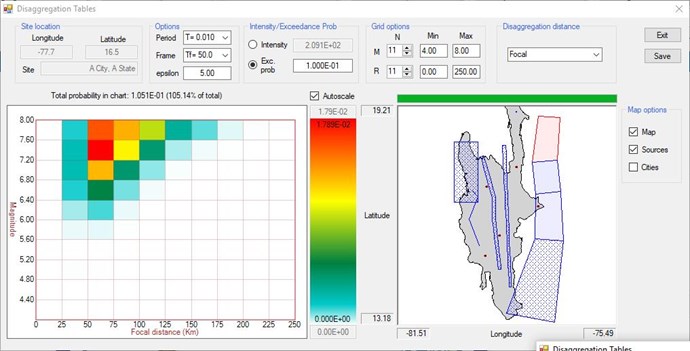
CAPRA Island Model with only seismic source 4 activated:
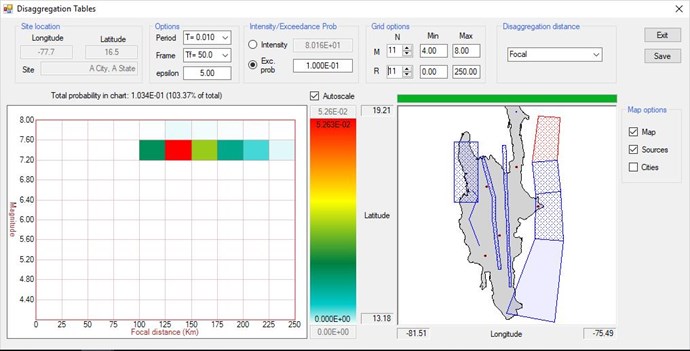
It can be observed disaggregation results are different, it is because the disaggregation analysis only considers the seismic sources activated.
I hope this solves your question.
Thank you for your interest in R-CRISIS.
Best regards,

How to understand deaggregation output in r-crisis? and what does "total probability In the chart" mean? why the value not 100% ?
I really appreciate your answer, sir
Thank you
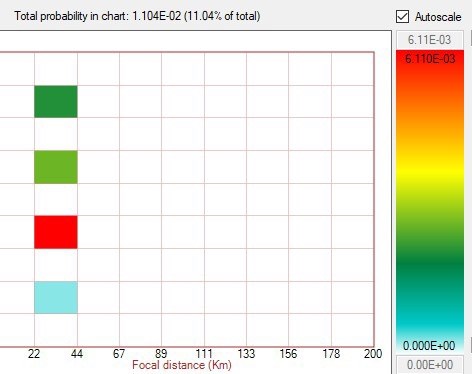
Dear Rahma,
This article was directly taken from the R-CRISIS Help Menu.
I hope it solves your questions.
CRISIS can generate exceedance rates disaggregated by magnitude, distance and "epsilon" value. The program presents these values graphically, in the disaggregation screen.
To see disaggregation results in this screen the following operations are needed:
Select the site for which results are desired by pointing to it with the mouse in the right-hand side picture box, which shows either the computation grid or the list of sites. The actual point used for the disaggregation computations will be the one belonging to the grid or list of computation sites that is the closest to the point clicked by the user. The actual point used for disaggregation will be indicated in the "Site Location" frame:
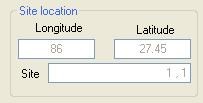
Choose the desired intensity measure (usually, a spectral ordinate associated to a structural period), time frame and epsilon value in the "Options" frame:
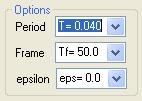
Choose, in the "Intensity/Return period" frame, the value of intensity for which disaggregation results will be presented or choose the desired exceedance probability (CRISIS will compute exceedance probability if intensity is given or intensity if exceedance probability is given):
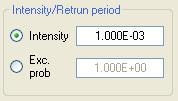
Use the "Grid options" frame to define the size of the disaggregation chart, giving the limits for magnitude and distance, as well as the number of cells in each direction:
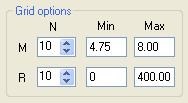
In general, disaggregation charts will be redrawn every time a parameter change is made.
Results will be shown in a disaggregation chart like the following:
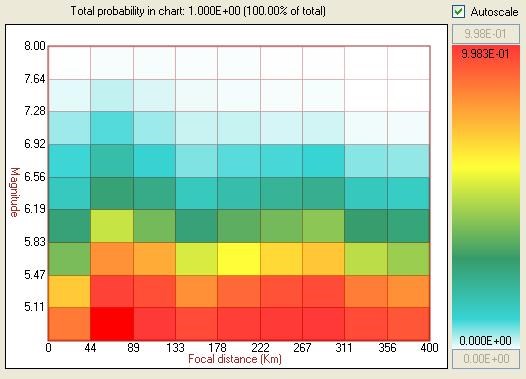
The value in each cell is the probability that the selected intensity level is exceeded in a given time frame if only earthquakes with magnitudes and distance within the cell's range are accounted for. The color scale will adjust automatically if "Autoscale" is selected. The user, however, can change the upper (red color) and lower (white color) limits of the scale, once the "Autoscale" option is disactivated.
On top of the disaggregation chart, CRISIS shows the following legend:
"Total probability in chart: 0.000E+00 (100.00% of total)"
This legend indicates that, with the current grid settings (magnitude and distance limits) and the selected "epsilon" level, the total probability of exceedance is a certain percentage of the total exceedance probability (for all magnitudes and distances, and epsilon equal to minus infinity).
However, the total probability is computed by interpolation of a previously computed hazard curve for the site. If computation of this hazard curve was made for a small number of intensity levels, the interpolation will not be exact, and percentages reported by the legend could be somehow inexact. To solve this problem, simply compute the hazard curves with a larger number of intensity levels.
When seeing CRISIS disaggregation results, the user must not expect that the exceedance probabilities associated to each cell used for the disaggregation add up to the total exceedance probability computed for the same site, intensity value and time frame. As shown in this link, arithmetic of exceedance probabilities is more complex to that of intensity exceedance rates used in conventional hazard studies.
Disaggregation charts can be saved using button “Save”, which will save in a text file the currently displayed chart settings, as well as the matrix of disaggregated hazard values.
Thank you for your interest in R-CRISIS.
Best regards,

thanks for your help explaining the disaggregation of R-Crisis.
Rahma
Dear Rahma,
It is a pleasure to help you.
Thank you for your interest in R-CRISIS.
Best regards,

Estimado Sebastian Giraldo,
Tengo algunas consultas, por que en algunos casos tengo una probabilidad total mayor a la del 100%, especialmente en periodos de retorno pequeños en contraste con los periodos de retorno mayores donde tengo un valor menor al 100%?
Estimado Luis Fernando,
La probabilidad total se calcula por medio de una interpolación de la curva de peligro asociada al sitio en interés. Si el cálculo de la curva de peligro se hizo con pocos niveles de intensidad, la interpolación no será exacta y posiblemente se presenten valores como los que usted está obteniendo. Para solucionar este problema, simplemente aumente el número de puntos de cálculo de la curva de peligro:
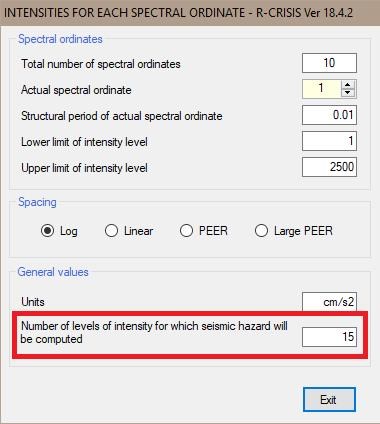
Gracias por su preferencia e interés en R-CRISIS.
Saludos,

Dear sir,
I want to access a disaggregation result but in all of my project it couldn't happen and show a error like this:
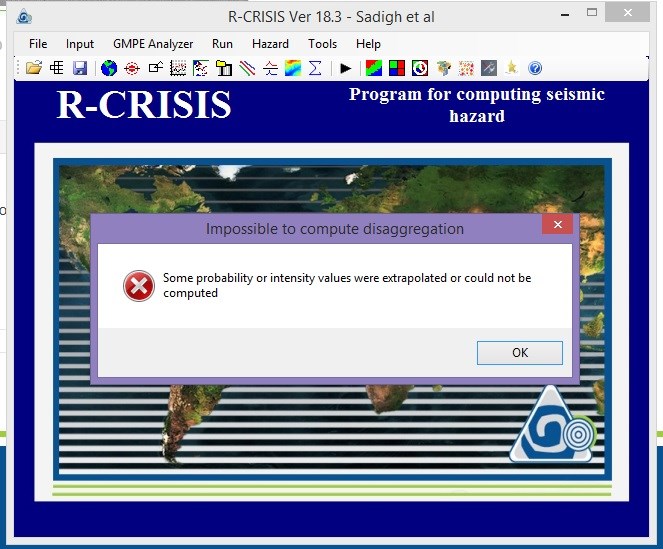
and when I open that chart it doesn't show the results. I change the step of spectral ordinates and run more than ten times but the problem didn't fix!!! what should I do? please help me...
Thank you
Dear Amirali,
That error message appears when the point where you are asking for the disaggregation results is outside of the calculation grid defined in the R-CRISIS. You should verify that.
If it does not bother you, I can check your model and look for this error. I only need the .DAT and all auxiliary files. Send the files to r-crisis@ern.com.mx
Thank you for your preference and interest in R-CRISIS.
Best regards,

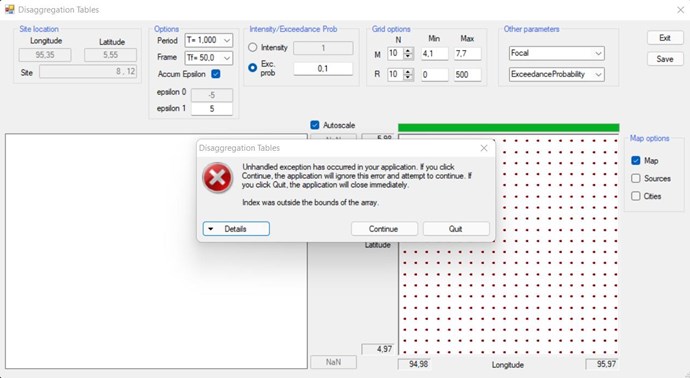
I've got the results of the psha analysis, but when I want to open the dissaggregation menu, a warning appears as shown in the image below, where do you think the problem is? I hope someone can help solve the problem I'm getting, thank you